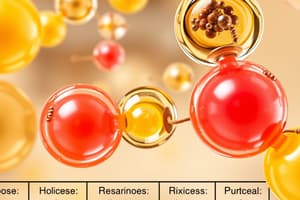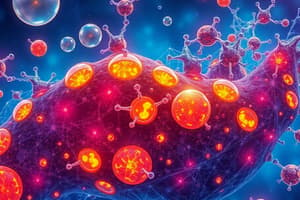Podcast
Questions and Answers
Which of the following best describes the primary role of phospholipids containing choline, such as lecithin, in the human body?
Which of the following best describes the primary role of phospholipids containing choline, such as lecithin, in the human body?
- Playing a crucial role in nerve transmission and acting as methyl donors. (correct)
- Preventing the adherence of alveolar walls in the lungs.
- Aiding in cholesterol solubilization and bile formation.
- Acting as a precursor for second messengers in hormonal action.
A patient is diagnosed with Niemann-Pick disease. Which enzyme deficiency is most directly associated with this condition?
A patient is diagnosed with Niemann-Pick disease. Which enzyme deficiency is most directly associated with this condition?
- Hormone-sensitive lipase
- Sphingomyelinase (correct)
- Lipoprotein lipase
- Glucocerebrosidase
In the biosynthesis of triacylglycerols, what is the initial step for activating fatty acids?
In the biosynthesis of triacylglycerols, what is the initial step for activating fatty acids?
- Conversion to fatty acyl CoAs by thiokinase. (correct)
- Esterification with glycerol-3-phosphate.
- Acylation by acyltransferase.
- Hydrolysis by hormone-sensitive lipase.
Which of the following is a key function of carnitine in fatty acid metabolism?
Which of the following is a key function of carnitine in fatty acid metabolism?
During the degradation of dietary lipids, which enzyme is responsible for hydrolyzing triacylglycerols in the bloodstream, facilitating the uptake of glycerol and free fatty acids by tissues?
During the degradation of dietary lipids, which enzyme is responsible for hydrolyzing triacylglycerols in the bloodstream, facilitating the uptake of glycerol and free fatty acids by tissues?
Under conditions of increased energy availability within a cell, how is beta-oxidation regulated?
Under conditions of increased energy availability within a cell, how is beta-oxidation regulated?
How does insulin primarily influence fatty acid synthesis?
How does insulin primarily influence fatty acid synthesis?
In the context of lipid metabolism, what is the primary purpose of ketogenesis?
In the context of lipid metabolism, what is the primary purpose of ketogenesis?
Which condition is most directly associated with a deficiency in glucocerebrosidase?
Which condition is most directly associated with a deficiency in glucocerebrosidase?
A patient with carnitine deficiency is likely to exhibit which of the following metabolic abnormalities?
A patient with carnitine deficiency is likely to exhibit which of the following metabolic abnormalities?
Which of the following is most directly associated with Zellweger's syndrome?
Which of the following is most directly associated with Zellweger's syndrome?
Which of the following fatty acids is classified as a medium-chain fatty acid?
Which of the following fatty acids is classified as a medium-chain fatty acid?
What is the primary function of hormone-sensitive lipase (HSL) in adipocytes?
What is the primary function of hormone-sensitive lipase (HSL) in adipocytes?
Which of the following is the primary reason why brain tissue cannot directly utilize fatty acids for energy?
Which of the following is the primary reason why brain tissue cannot directly utilize fatty acids for energy?
What outcome results from the activation of hormone-sensitive lipase?
What outcome results from the activation of hormone-sensitive lipase?
In the context of fatty acid synthesis, what role do citrate levels play?
In the context of fatty acid synthesis, what role do citrate levels play?
Which of the following best describes the function of LCAT (lecithin-cholesterol acyltransferase)?
Which of the following best describes the function of LCAT (lecithin-cholesterol acyltransferase)?
In the regulation of lipolysis in adipocytes, what effect do insulin and glucagon have on the process?
In the regulation of lipolysis in adipocytes, what effect do insulin and glucagon have on the process?
What is the significance of dihydroxyacetone phosphate in triacylglycerol synthesis within adipose tissue?
What is the significance of dihydroxyacetone phosphate in triacylglycerol synthesis within adipose tissue?
Which of the following is the MOST accurate statement regarding the digestion and absorption of cholesterol?
Which of the following is the MOST accurate statement regarding the digestion and absorption of cholesterol?
Lipotropic factors are crucial for liver health. Which outcome results from deficiency in these factors within the liver?
Lipotropic factors are crucial for liver health. Which outcome results from deficiency in these factors within the liver?
Which statement accurately describes the location and key events of beta-oxidation?
Which statement accurately describes the location and key events of beta-oxidation?
An individual with a genetic defect affecting beta-oxidation may experience?
An individual with a genetic defect affecting beta-oxidation may experience?
Which condition would MOST likely promote ketogenesis?
Which condition would MOST likely promote ketogenesis?
What is the primary function of cytoplamic fatty acid synthesis?
What is the primary function of cytoplamic fatty acid synthesis?
The fatty acid called arachidic acid is classified as?
The fatty acid called arachidic acid is classified as?
The ester formed of a fatty acid and a higher alcohol is called?
The ester formed of a fatty acid and a higher alcohol is called?
What simple lipids contain glycerol?
What simple lipids contain glycerol?
A complete description of the formula for palmitoleic acid would include?
A complete description of the formula for palmitoleic acid would include?
Which of the following contains two palmitic acid residues, acts as a surfactant in the lung, and if deficient leads to Respiratory distress syndrome?
Which of the following contains two palmitic acid residues, acts as a surfactant in the lung, and if deficient leads to Respiratory distress syndrome?
What is the function of phosphatidylinositol (lipositol), as it relates to cell communication?
What is the function of phosphatidylinositol (lipositol), as it relates to cell communication?
Which of the following lipids is present in high concentration in brain and nerve tissue?
Which of the following lipids is present in high concentration in brain and nerve tissue?
Cerebrosides are present in many tissues and?
Cerebrosides are present in many tissues and?
Regarding lipid digestion, triglycerides are emulsified in the presence of bile salts from the liver, and then digested by lipase mostly secreted from the?
Regarding lipid digestion, triglycerides are emulsified in the presence of bile salts from the liver, and then digested by lipase mostly secreted from the?
In fatty acid oxidation, successive cleavages with release of acetyl CoA is known as?
In fatty acid oxidation, successive cleavages with release of acetyl CoA is known as?
In fatty acid synthesis, the cytoplasmic pathway, the enzyme used in carboxylation of acetyl CoA to form malonyl CoA is called?
In fatty acid synthesis, the cytoplasmic pathway, the enzyme used in carboxylation of acetyl CoA to form malonyl CoA is called?
Flashcards
Lipid Classifications
Lipid Classifications
Simple lipids are fats (acylglycerols) and waxes. Compound lipids include phospholipids, glycolipids, and lipoproteins. Derived lipids include fatty acids, steroids, and fat-soluble vitamins.
Fatty Acid Chain Lengths
Fatty Acid Chain Lengths
Fatty acids are building blocks of lipids, with short, medium, long, and very long chains. Examples: Acetic, Butyric, Caproic, Capric, Palmitic, Stearic, Arachidic, and Lignoceric acids.
Essential Fatty Acids (Definition)
Essential Fatty Acids (Definition)
These cannot be synthesized in the body, must be obtained from diet. Includes linoleic, α linolenic and arachidonic acids.
Triacylglycerol (TAG)
Triacylglycerol (TAG)
Signup and view all the flashcards
Phospholipids
Phospholipids
Signup and view all the flashcards
Sphingolipids
Sphingolipids
Signup and view all the flashcards
Glycolipids
Glycolipids
Signup and view all the flashcards
Digestion of Lipids
Digestion of Lipids
Signup and view all the flashcards
Biosynthesis of Triacylglycerols
Biosynthesis of Triacylglycerols
Signup and view all the flashcards
TAG Formation
TAG Formation
Signup and view all the flashcards
Lipolysis
Lipolysis
Signup and view all the flashcards
Hormone-Sensitive Lipase
Hormone-Sensitive Lipase
Signup and view all the flashcards
Regulation of Lipolysis
Regulation of Lipolysis
Signup and view all the flashcards
Lipolytic Hormones
Lipolytic Hormones
Signup and view all the flashcards
β-oxidation of fatty acids
β-oxidation of fatty acids
Signup and view all the flashcards
Regulation of β-oxidation
Regulation of β-oxidation
Signup and view all the flashcards
Defects in Fatty Acid Oxidation
Defects in Fatty Acid Oxidation
Signup and view all the flashcards
Alpha-Oxidation
Alpha-Oxidation
Signup and view all the flashcards
Refsum's disease (Cause)
Refsum's disease (Cause)
Signup and view all the flashcards
Zellweger's Syndrome
Zellweger's Syndrome
Signup and view all the flashcards
Cytoplasmic Fatty Acid Synthesis
Cytoplasmic Fatty Acid Synthesis
Signup and view all the flashcards
NADPH+H+
NADPH+H+
Signup and view all the flashcards
Esterification
Esterification
Signup and view all the flashcards
Insulin's Stimuli
Insulin's Stimuli
Signup and view all the flashcards
Definition and Composition of Phospholipids
Definition and Composition of Phospholipids
Signup and view all the flashcards
Ketogenesis (Definition)
Ketogenesis (Definition)
Signup and view all the flashcards
Source of Energy
Source of Energy
Signup and view all the flashcards
Ketolysis
Ketolysis
Signup and view all the flashcards
Fatty Liver
Fatty Liver
Signup and view all the flashcards
Lipotropic Factors (Definition)
Lipotropic Factors (Definition)
Signup and view all the flashcards
Study Notes
- Lipids are categorized into simple, compound, and derived types.
Lipid Classification
- Simple lipids include fats (acylglycerols) made of glycerol and fatty acids, and waxes composed of higher alcohols and fatty acids.
- Compound lipids consist of phospholipids (glycerophospholipids and sphingophospholipids), glycolipids (cerebrosides, gangliosides, and ceramide oligosaccharides), and lipoproteins (chylomicrons, VLDL, LDL, and HDL).
- Derived lipids include fatty acids, steroids, fat-soluble vitamins, ketone bodies, carotenoids, and cholanthrenes.
Fatty Acids
- Fatty acids vary in chain length (short, medium, long, very long) and chemical formula.
- Short-chain fatty acids:
- Acetic acid (C2, CH3-COOH)
- Butyric acid (C4, CH3-(CH2)2-COOH)
- Caproic acid (C6, CH3-(CH2)4-COOH)
- Medium-chain fatty acids:
- Capric acid (C10, CH3-(CH2)8-COOH)
- Long-chain fatty acids:
- Palmitic acid (C16, CH3-(CH2)14-COOH)
- Stearic acid (C18, CH3-(CH2)16-COOH)
- Arachidic acid (C20, CH3-(CH2)18-COOH)
- Very long-chain fatty acids:
- Lignoceric acid (C24, CH3-(CH2)22-COOH)
Mono-Unsaturated Fatty Acids
- Includes palmitoleic acid (ω7,16:1), oleic acid (ω9,18:1), and nervonic acid (ω9,24:1).
- Palmitoleic acid formula: CH3(CH2)5CH=CH(CH2)7COOH
- Oleic acid formula: CH3(CH2)7CH=CH(CH2)7COOH
- Nervonic acid formula: CH3(CH2)13CH=CH(CH2)7COOH
Unsaturated Fatty Acids
- ω3: α-linolenic (18:3) and timnodonic (20:5).
- ω6: linoleic acid (18:2) and arachidonic acid (20:4).
- ω9: oleic acid (18:1).
- ω7: palmitoleic acid (16:1).
Essential Fatty Acids
- Cannot be synthesized in the body and must be obtained from the diet.
- Includes PUFAs like linoleic and α-linolenic acids, and ω-3 fatty acids.
Simple Lipids
- Esters of fatty acids and alcohol only.
- If the alcohol is glycerol, it forms triacylglycerols (TAGs).
- If the alcohol is a higher alcohol, it forms waxes.
Triacylglycerols (TAG)
- Monoacylglycerol has one fatty acid attached to glycerol.
- Diacylglycerol has two fatty acids attached to glycerol.
- Triacylglycerol has three fatty acids attached to glycerol.
Phospholipids
- Esters of fatty acids and alcohol with phosphate. If alcohol is glycerol, it forms glycerophospholipids. If alcohol is higher, it forms sphingophospholipids.
- Phospholipid structure includes saturated fatty acid at C1, unsaturated fatty acid at C2, and phosphoric acid residue at position C3.
Glycerophospholipids
- Example is phosphatidic acid.
Cardiolipin (Diphosphatidylglycerol)
- Stimulates antibody formation and is antigenic.
Phosphatidylserine
- One of the activating factors of the coagulation mechanism.
Lecithin (Phosphatidylcholine)
- Dipalmitoyl lecithin acts as a surfactant in the lung.
- Defect leads to respiratory distress syndrome (hyaline membrane disease).
Lysophospholipids
- Include lysolecithin and lysocephalin.
Lipositol (Phosphatidylinositol)
- Present in the cell membrane and acts as a precursor of second messengers (inositol triphosphate), mediating hormonal action inside cells.
Plasmalogen
- Functions of phospholipids include being present in every body cell (cell membrane) and acting as a lipotropic factor to prevent fat accumulation in the liver
- Phospholipids containing choline (lecithin) are important in nerve transmission and act as methyl donors in transmethylation reactions.
- Dipalmityllecithin acts as a lung surfactant, preventing adherence of alveolar walls
- Cephalin plays a role in the coagulation mechanism.
- Phosphatidylinositol (lipositol) acts as a precursor of second messengers, mediating hormonal action inside cells.
Sphingophospholipids
- Esters of fatty acids and alcohol with phosphate.
Sphingolipid
- Sphingomyelin is present in high concentrations in brain and nerve tissue:
- Niemann-Pick disease is caused by the accumulation of sphingomyelin in the liver due to deficiency of sphingomyelinase enzyme, which can lead to mental retardation and early death.
Sphingolipids and Glycolipids
- Sphingolipids contains lipid and sphingosine alcohol.
- Sphingophospholipids contain sphingosine, fatty acids, phosphate, and a base.
- Glycolipids contain sphingosine, fatty acids, and carbohydrates.
- Glycolipids are complex lipids containing carbohydrates and sphingosine. Include sulfolipids and gangliosides.
Cerebrosides
- Simple glycolipids present in many tissues, specifically in the brain and myelin of nerve fibers, acting as insulators of nerve impulses.
- Degradation is done by glucocerebrosidase, with deficiency leading to Gaucher's disease, which is characterized by mental retardation, enlarged liver, and spleen in children. Gaucher disease also features the accumulation of cerebrosides in phagocytes due to glucocerebrosidase enzyme deficiency and manifests as mental retardation, hepatomegaly, and bone disorders.
- Sulpholipids (sulphatides) are cerebrosides containing a sulfate group.
- Gangliosides contain sphingosine base, fatty acid (C24), and many glucose and galactose units, found in heart and kidney.
Lipid Metabolism
- Adult humans ingest 60-150 g of lipids/day, >90% being triacylglycerol (TAG); the rest is cholesterol, cholesteryl esters, phospholipids, and free fatty acids (FFAs).
Lipid Digestion
- Triglycerides are digested by lipase enzymes: lingual, gastric, pancreatic, and intestinal lipase.
- End products of TAG digestion are 2-monoacylglycerols (72%), 1-monoacylglycerols (6%), and glycerol and free fatty acids (22%).
- Cholesterol esters are digested by cholesterol esterase from pancreatic juice into cholesterol and free fatty acids.
- Phospholipids are absorbed as is or digested by phospholipase enzymes (A1, A2 (B), C, and D).
- Dietary lipids (especially TAG) form complexes with protein lipoprotein (chylomicron) and are absorbed into lymphatic circulation, then systemic circulation.
- In blood, lipoprotein lipase hydrolyzes TAG into glycerol and FFAs. Glycerol and FFAs are taken up by different tissues for depot fat, energy production (β-oxidation), and synthesis of biologically active compounds (glycolipids).
Biosynthesis of Triacylglycerols
- TAGs are neutral fats, triglycerides and the majority of lipids in the body, functions to store metabolic energy, and occurs in microsomes of liver, kidney, intestine, adipose tissues, and lactating mammary glands.
- Glycerol and fatty acids must be activated by ATP before incorporation into acylglycerols.
Activation of Fatty Acids
- Fatty acids are activated to fatty acyl CoAs.
Activation of Glycerol
- Glycerol is activated to glycerol-3-phosphate by glycerol kinase in most tissues.
- Adipose tissue lacks glycerol kinase, relies on carbohydrate metabolism for glycerol-3-phosphate, and requires GLUT-4 (insulin-dependent) for glucose entry.
Synthesis of TAGs (Esterification)
- Mainly in liver and adipose tissue, storage occurs in adipose tissue.
Regulation of Insulin
- After a meal, stimulates glucose transport into adipose cells (glycolysis).
- Glycolysis supplies dihydroxyacetone phosphate, which is converted into glycerol phosphate in adipose tissue.
- Insulin stimulates the secretion of lipoprotein lipase (LPL), hydrolyzes endogenous and dietary TAGs in plasma lipoproteins (chylomicrons and VLDL) to release fatty acids (FA) and glycerol.
Breakdown of Triacylglycerols (Lipolysis)
- Hydrolysis of TAGs releases glycerol and free fatty acids, which is occurs in the cytosol of adipose tissue cells. The TAG stores in adipose tissue are continually undergoing hydrolysis (lipolysis) and re-esterification. Glycerol from lipolysis is taken up by the liver or kidney for gluconeogenesis or re-esterification. FFAs are transported in blood with albumin and taken by various tissues (liver, kidney, muscles, etc.) for β-Oxidation.
Steps of Lipolysis
- Involves three lipases hydrolyzing the three fatty acids of the triacylglycerols.
- The rate-limiting step is catalyzed by hormone-sensitive lipase.
- Diacyl- and mono-acylglycerol lipases are present in excess, ensures completion once hormone-sensitive lipase is activated.
Regulation of Lipolysis in Adipocytes
- Lipolysis regulation depends on if the body is fasting, feeding, or in other states.
- Activation is hormone sensitive lipase (phosphorylation by kinase)
- Inactivation is hormone sensitive lipase (dephosphorylation by phosphatase)
During Fasting - Lipolytic Hormones
- Epinephrine, norepinephrine, and glucagon activate cell membrane-bound adenylate cyclase, which converts ATP into cAMP within the cell. The increased cAMP activates cAMP-dependent protein kinase, activating the hormone-sensitive lipase.
- Other hormones, including thyroxine, glucocorticoids, and growth hormone, increase cAMP levels.
During Feeding - Antilipolytic Hormones
- Insulin reduces cAMP level by inducing phosphodiesterase. This catalyzies cAMP into AMP and induces lipase phosphatase activity. Inactivating hormone-sensitive lipase and lipolysis.
- Insulin increases GLUT4, increasing glucose uptake by muscle and adipose tissue and leading to increased DHAP and glyceraldehyde 3-phosphate.
Additional Factors
- Caffeine inhibits phosphodiesterase enzyme aiding stimulation of Lipolysis.
- Nicotinic acid and PGE1 inhibit adenyl cyclase and inhibit lipolysis
Excessive Lipolysis
- This can occur in conditions where the need for energy is increased (low insulin and high glucagon).
- Typically happens during starvation, diabetes mellitus, low carbohydrate diet, and hypercatabolic states.
Fatty Acid Oxidation
- Also known as Beta-Oxidation and catabolizes fatty acids to give ATP and acetyl CoA during fasting. It requires several collectively enzymes called fatty acid oxidase.
- The site is Mitochrondrial matrix of all cell tissues especially liver.
- Note, the blood brain barrier prevents fatty acid chains from being long to the brain.
Steps of Beta Oxidation
- Activation of free fatty acids into acyl CoA
- Translocation of acyl CoA from cytosol to mitochondria by carnitine transporter system
- Beta oxidation in the mitochondrial matrix
- Oxidation, Hydration, Oxidation, Cleavage.
Activation of Fatty Acids
- Activation of free fatty acids into acyl-CoA is performed by thiokinase enzyme in the presence of CoASH and ATP.
Translocation of Acyl-CoA
- Translocation of acyl-CoA to mitochondria is performed by the carnitine transporter system.
- Long-chain fatty acyl-CoAs cannot diffuse across the inner mitochondrial membrane, only passing combined with carnitine.
- Carnitine is synthesized from lysine and methionine in liver and kidney.
Enzymes in Carnitine Shuttle
- Includes Carnitine acyl transferase I (CATI)
- Also includes Carnitine acylcarnitine translocase
- Additionally contains Carnitine acylcarnitine transferase II (CATII)
- Function of carnitine is to transport long chain fatty acyl CoA into the mitochondria.
Bioenergetics of B-Oxidation of Palmitate
- In β-Oxidation, 7 FADH2 = 7 x 1.5= 10.5 ATP, 7 NADH = 7 x 2.5 = 17.5 ATP, consumes 2 ATP to activate the free palmitate to give palmityl CoA. Net yield = 26 ATP per mole of palmitate.
In TCA
- 8 acetyl-CoA molecules from β-oxidation are oxidized by TCA to give 8 X 10 ATP = 80 ATP. Complete oxidation of palmititoyle CoA (16 C) gives 26 + 80 = 106 ATP.
- Importance of B-Oxidation: Source of energy: Oxidation of fatty acid is a major source of energy during starvation.
- Production of acetyl CoA: Acetyl CoA is converted to other compounds. Acetyl CoA can also be used as fuel as cholesterol, ketone body and other acetylation reaction. Regulation of B-oxidation:
- Free fatty acid oxidation is regulated by the energy needs of cells:
- Energy increases (↑ ATP), β-oxidation is inhibited and vice versa.
- Malonyl CoA formed during F.A. synthesis inhibit CAT1:
- Carbohydrate feeding leads to release of Insulin. Beta oxidation is regulated with insulin in this way. Anti-insulin hormones produce reverse thus increasing FFA oxidation.
Diseases of B-oxidation
- MCAD (medium chain acyl-Co-A dehydrogenase) deficiency is is most common
- Carnitine, CPT - I and CPT - II deficiencies have the same effects
- Genetic defects lead to fasting hypoketotic hypoglycemia and organic acidosis, muscle weakness, myoglobinuria, and cardiomyopathy and hyperammonemia, leading to coma, brain damage and death. N.B, MCAD deficiency causes ↑acylcarnitine and dicarboxylate. Carnitine deficiency→ carnitine and acylcarnitine.
- Treatment:
- Oral carnitine may be beneficial in primary carnitine deficiency
- Avoid fasting and strenuous exercise for all patients
- Diet containing high-carbohydrate, low-fat containing medium chain fatty acids (but not in MCAD).
B-Oxidation of Unsaturated/Odd Number Fatty Acids
- More energy is produced with each double bond. For each double bond less 2 ATP are produced per 1 cycle.
- Then propionyl CoA is converted to succinyl CoA and enter Citric acid cycle.
Alpha Oxidation
- Oxidation of phytanic acid occurs in micromose of the brain and nerve tissues.
- Causes include inherited deficiency of enzymes responsible for oxidation of phytanic acid.
- Symptoms include accumulation of phytanic acid in nervous tissue that can produce deafness and blindness.
- Beta oxidation is needed along side alpha one to fully process.
Omega Oxidation
- Produces dicarboxylic fatty acids in minor pathway by hydroxylase cytochrome P450.
Peroxisomal Oxidation of Fatty Acids
- Oxidation of super long fatty acid chains (C20, C22)
Zellwegers syndrome
- Absence of peroxisomes in all tissues. Causing a accumulation of long fatty acids in the brain liver and kidneys.
- Symptoms include liver and kidney malfunction
- Prognosis: die before 1 year.
F.A synthesis
- Cytoplasmic and microsomal
Cytoplasmic fatty acids synthesis
- Extramitochondrial and de novo synthesis. Product is palmate (16C). Site of the cyosol including liver, mammlary glad and kidney. This pathway needs acetyl coA, NADPH and fatty synthase complex. Acetyl COA is provided by glucose(glycolysis)
Palmitate production
- Fatty acid synthase complex works better if palmitate (a chemical in acetyl coA) is applied to each carbon
NADPH+H is provided 3 ways:
-
- Pentose phosphate pathway
-
- Cyosol action of isocitrate dehydrogenase
-
- Action of malic enzyme on malate
Steps of Cytoplasmic Pathway
- Carboxylation of acetyl CoA to form malonyl CoA: Malonyl Co A is synthesized from acetyl CoA by acetyl Co A carboxylase in the presence of biotin and ATP (Key step in pathway).:
Metabolic Conjugation
- Is composed of phospholipids containing phosphate. If: They contain alcohol (glycerol or sphingosine), fatty acid(s), and a nitrogenous base. types: Choline, serine, ethanolamine, and inositol.
Synthesis & Activation
- Activation of fatty acids into acyl CoA. Synthesis of 1,2 diacylglycerol. Activation of choline into CDP-choline
- Reaction of 1,2 diacylglycerol with COP-choline to form lecithin.
Synthesis Of Ehtanoalmine and Others
- Simmilar to ehtanolmine, however utilizes active ethanolamine instead of active choline
General Phospholipid process
-
- Act fatty acids into acyl CoA. 2 Synthesize diacyglycerol . Then have that create your compound by adding one of the factors to it. Biosynthesis process has all steps in it with images to understand and visualize
- Degradation is preformed by phosphllpases A1 A2 C and D. Most tissues have it. Has a palmlate cycle
- Enzymes LCAT helps in this process too.
Synthesis of Sphingomyelin:
- Synthesis of sphingosine from amino acid serine and active palmitic acid palmityl CoA and serine→ Sphingosine
- This degradation preformed by Niemann Pick and lysol
- Functions act in structure and cell membrane
- Act as neurotransmitters
- Prevent fatty acid in liver
Process Of Glycolipids
- Has same steps from synthesis. Except with a different final process
- Cerebrosides synthesis has 3 main steps:
Studying That Suits You
Use AI to generate personalized quizzes and flashcards to suit your learning preferences.




